- Credit cards
- View all credit cards
- Banking guide
- Loans guide
- Insurance guide
- Personal finance
- View all personal finance
- Small business
- Small business guide
- View all taxes

You’re our first priority. Every time.
We believe everyone should be able to make financial decisions with confidence. And while our site doesn’t feature every company or financial product available on the market, we’re proud that the guidance we offer, the information we provide and the tools we create are objective, independent, straightforward — and free.
So how do we make money? Our partners compensate us. This may influence which products we review and write about (and where those products appear on the site), but it in no way affects our recommendations or advice, which are grounded in thousands of hours of research. Our partners cannot pay us to guarantee favorable reviews of their products or services. Here is a list of our partners .
Travel Inflation Report: May 2024

Many or all of the products featured here are from our partners who compensate us. This influences which products we write about and where and how the product appears on a page. However, this does not influence our evaluations. Our opinions are our own. Here is a list of our partners and here's how we make money .
Table of Contents
How airfares have changed
How hotels room rates have changed, how rental car prices have changed, how restaurant prices have changed, how the price of movies, theaters and concerts has changed, smart money move: use travel rewards cards to book, if you’re planning to travel in 2024….
Some good news for travelers: Airfares, car rental and hotel prices are down versus March 2023. Falling travel prices is a bright spot for customers, considering that the price of pretty much everything else is going up. In fact, average consumer prices across all items rose 3.5% year-over-year through March.
According to NerdWallet's Travel Price Index, the overall cost of travel is down 2% from the same month in 2023 and up 15% compared with March 2019 (the last fully-normal March before lockdowns). In short, expect the same trip taken this year to cost slightly less than it did this time last year, but more than it would if you had taken the trip before the pandemic.
Despite travel costs declining year-over-year, there are still things you can do to reduce the price of your trip. Check out our smart money suggestions below.
NerdWallet's Travel Price Index combines data from individual travel categories tracked by the Bureau of Labor Statistics' Consumer Price Index data, such as airfares, lodging, meals and rental cars.
Overall prices for the past 12 months through March 2024 rose 3.5% before seasonal adjustment. Still, not every individual line item experiences inflation at the same rate — especially when it comes to travel prices. Some types of trips might actually be more or less expensive than in the past, depending on if your trip involves airfare versus driving, if you’re staying in a hotel and whether it involves a rental car.
To help you better understand how travel prices have changed, NerdWallet honed in on five categories:
Car rentals.
Food away from home.
Movies, theaters and concerts.
NerdWallet then compared those costs to their same prices a month ago and a year ago. And given how significantly COVID-19 altered the state of travel, the data also compares today’s prices to the same cost of those things pre-pandemic. For example, March 2024 is compared to March 2019 as the last corresponding pre-pandemic month.
Here’s what today’s travel prices look like:
When comparing March 2024 prices versus March 2023, U.S. airfares are down 7.1%. Even compared to pre-pandemic prices, airfares only rose by 2.6% in March 2024 versus March 2019. That's not a lot considering average prices as a whole are up by 22.8% since March 2019.
Prices for lodging away from home — including hotels and motels in U.S. cities — did increase 6.7% month-over-month. Though, they actually decreased over the past year, falling by 2.4% versus March 2023.
Unlike airfares that are lower than pre-pandemic prices, hotel and motel prices are significantly higher than what they were pre-pandemic — though still not as high as the 22.8% all-items average increase.
High rental car prices were one of the biggest stories of pandemic-era travel. Though prices have leveled off, they are still up an astounding 39.3% versus the same month in 2019. Still, the costs are better now than they were a year ago. Car rental prices are down 8.8% year-over-year.
Food prices consistently rise nearly every month, and this month was no exception. In March 2024, the cost of food away from home was up 4.2% versus the same month in 2023.
And prices are far higher than pre-pandemic, with March 2024 prices coming in at 29.3% higher than what they were in March 2019. That's higher than the inflation rate across all items, suggesting that restaurant prices have risen more than many other categories of goods.
Like restaurants, entertainment prices see fairly consistent increases — save for a small dip in 2020. Prices are now up 22.6% from what they were in March 2019. The year-over-year price increases are up 5%.
Paying for travel with points and miles versus cash isn’t as daunting a task as it may seem. Frequent flyer miles and hotel points can be accrued not just for recurring travel, but through other outlets as well. Credit card rewards and welcome bonuses can be one of the most popular ways to accrue a big stash of points for a lot less effort than living your life out of a suitcase.
In addition, travel credit cards can offer various money saving perks, like:
Complimentary trip insurance .
Savings on checked bags .
Waived foreign transaction fees .
Airport lounge access .
Cash back credits that can offset the annual fee.
Here's a sampling of cards that offer travel-related statement credits.

on Citibank's application

on Bank of America's website
• 10 points per $1 on Chase Dining, hotel stays and car rentals purchased through Chase.
• 5 points per $1 on air travel purchased through Chase.
• 3 points per $1 on other travel and dining not booked with Chase.
• 1 point per $1 on other purchases.
• 3 points per $1 on air travel and hotels, supermarkets, gas stations and restaurants.
• 1 point per $1 on all other purchases.
• 5 points per $1 on prepaid hotels and car rentals booked directly in the Altitude Rewards Center.
• 3 points per $1 on eligible travel purchases and mobile wallet spending on Apple Pay, Google Pay and Samsung Pay.
$300 annual travel credit .
$100 annual hotel credit on bookings of $500 or more.
$325 annual credit.
$100 in airline incidental statement credits.
If you’re building your next vacation budget based on an early-pandemic-era trip, expect to pay far more now for pretty much every expense. Yet even though prices constantly feel like they’re getting higher, you can still save on travel with a little planning.
To avoid the costs of eating out, head to local grocery stores — which can be a fun activity on its own — or pack snacks from home. While in an airport, head to the lounge. Many credit cards have partnerships with airport lounge operators ( Priority Pass is a popular one) where you can typically expect complimentary snacks and drinks.
Methodology
NerdWallet conducted an analysis of the Bureau of Labor Statistics’ Consumer Price Index data released by the U.S. Department of Labor, which was most recently updated in April 2024 and measures prices of items like travel, groceries and cars. Prices usually change every month, but some prices change more than others.
Keep in mind, this data is based on March 2024 information, even though it is released in April 2024, so prices you actually see may have actually improved (or gotten even worse) than this data, because it lags one month behind.
And even within the realm of travel, some expenses might go up, while others might go down.
The NerdWallet Travel Price Index combines data from the Consumer Price Index, weighted by the estimated spending in each category, which is based on 2019 travel expenditure data from the BLS.
Here are the spending categories considered, and how heavily each was weighted:
Flights: 29%.
Car rental: 13%.
Lodging: 30%.
Entertainment: 7%.
How to maximize your rewards
You want a travel credit card that prioritizes what’s important to you. Here are our picks for the best travel credit cards of 2024 , including those best for:
Flexibility, point transfers and a large bonus: Chase Sapphire Preferred® Card
No annual fee: Bank of America® Travel Rewards credit card
Flat-rate travel rewards: Capital One Venture Rewards Credit Card
Bonus travel rewards and high-end perks: Chase Sapphire Reserve®
Luxury perks: The Platinum Card® from American Express
Business travelers: Ink Business Preferred® Credit Card

on Chase's website
1.5%-6.5% Enjoy 6.5% cash back on travel purchased through Chase Travel; 4.5% cash back on drugstore purchases and dining at restaurants, including takeout and eligible delivery service, and 3% on all other purchases (on up to $20,000 spent in the first year). After your first year or $20,000 spent, enjoy 5% cash back on travel purchased through Chase Travel, 3% cash back on drugstore purchases and dining at restaurants, including takeout and eligible delivery service, and unlimited 1.5% cash back on all other purchases.
$300 Earn an additional 1.5% cash back on everything you buy (on up to $20,000 spent in the first year) - worth up to $300 cash back!

on Capital One's website
2x-5x Earn unlimited 2X miles on every purchase, every day. Earn 5X miles on hotels and rental cars booked through Capital One Travel, where you'll get Capital One's best prices on thousands of trip options.
75,000 Enjoy a one-time bonus of 75,000 miles once you spend $4,000 on purchases within 3 months from account opening, equal to $750 in travel.

US Travel Header Utility Menu
- Future of Travel Mobility
- Travel Action Network
- Commission on Seamless & Secure Travel
- Travel Works
- Journey to Clean
Header Utility Social Links
- Follow us on FOLLOW US
- Follow us on Twitter
- Follow us on LinkedIn
- Follow us on Instagram
- Follow us on Facebook
User account menu
Travel price index.
MONTHLY INSIGHTS December 20, 2023
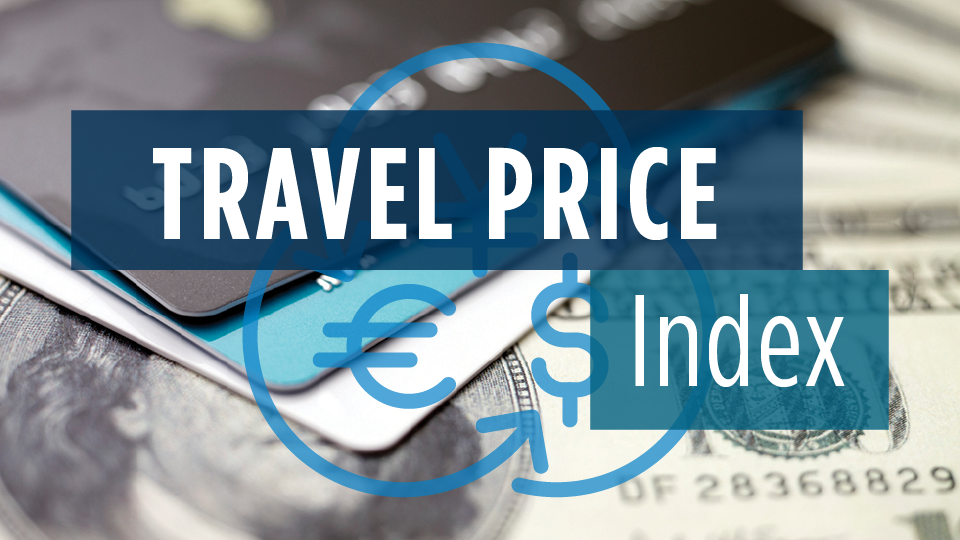
The Travel Price Index (TPI) measures the cost of travel away from home in the United States. It is based on the U.S. Department of Labor price data collected for the monthly Consumer Price Index (CPI). The TPI is released monthly and is directly comparable to the CPI.
Please see attached table for the latest data.
Member Price: $0
Non-Member Price: $0 Become a member to access.
Watch CBS News
Travelers should expect to see price increases in almost all areas of travel, expert says
June 10, 2022 / 1:21 PM EDT / CBS News
Tatiana White's high school graduation brought family from Georgia, Maryland and Connecticut to Daytona Beach, Florida. But vacation inflation has them spending more for just about everything.
For Evelize Cruz, her trip from Hartford to Daytona Beach cost her way more than she expected.
"I mean I wanted to keep it anywhere from $2,000, I'll probably be closer to four [thousand] by the end of this," she told CBS News' Kris Van Cleave.
The U.S. Department of Labor reported Friday that inflation accelerated across the U.S. in May, jumping to 8.6%.
It's not the only thing that is up—domestic airfare is costing flyers like Cruz 34% more than in 2019, according to travel app Hopper.
Lodging is also more expensive than it was before. Airbnb prices are up over 11% in 2022, airDNA, a vacation rental research website found. Hotel prices are also up —as well as rental cars which went up more than 70% compared to 2020.
"There are just so many expenses that people forget about when it comes to travel. But I do think the biggest pain point for people right now is those car rental prices," Sally French, travel rewards expert for NerdWallet, said.
Nerdwallet's research finds it also costs more to do things on vacation. Eating out costs 7.2% more than it did last year, and tickets for movies and concerts are up nearly 6%. Gas prices are at a record high , with the national average nearing $5, according to AAA.
Nearly 43% of Americans say that economic concerns are prompting them to reduce travel or cut their vacation budget.
"I was going to go to Antelope Canyon, Yosemite, Yellowstone," Sean Sherman, who was planning a summer family vacation, said. "I just said look we're putting it on the back burner right now and it broke some hearts but that's the reality."
More from CBS News

What will gold be worth by the end of 2024? Here's what some experts predict.

Justin Hartley shifts gears in new drama "Tracker"

From The Alamo to Tex-Mex: David Begnaud explores San Antonio

3 savings moves to make with inflation still rising
A year out from peak inflation, travel and leisure (mostly) cost less
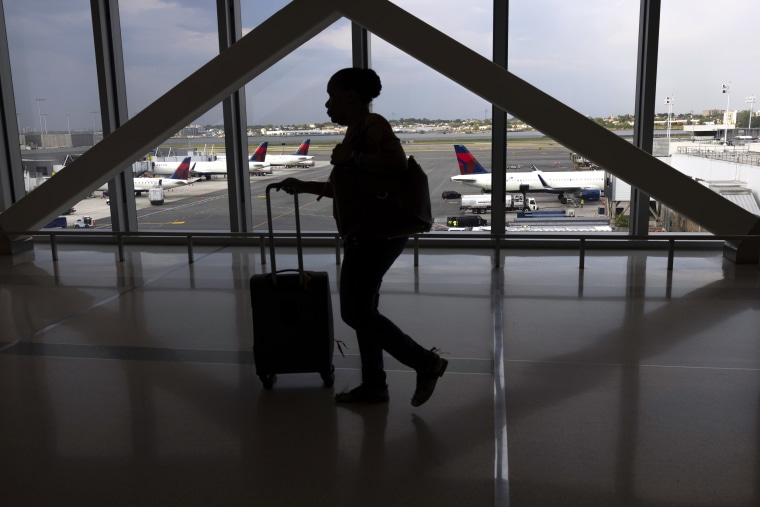
It took a while, but people are just about done catching up on experiences lost during the pandemic.
While a minority of high-dollar travelers are still confronting — and paying — four-figure airfares to Paris and Tokyo, prices are finally falling across the leisure economy, the last several months of federal data show.
That’s good news for consumers, as well as economists and policymakers seeking reasons for optimism that the economy can regain its footing without sliding into a recession.
Consumer Price Index figures released Wednesday morning showed airfares down 19% in June from last year and car rental rates down 12%, for their fifth consecutive month of declines. Food away from home, which includes restaurant meals, continued to rise, but the category’s annual growth rate of 7.7% in June slowed from 8.8% in March. Ticket prices for sporting events ticked up last month, but the rise came after three straight months of declines.
“It’s the consumer getting to the end of their ‘revenge spending,’” said Skanda Amarnath, the executive director of the macroeconomic policy group Employ America.
The downtrend comes one year after inflation peaked at a four-decade high of 9.1% in June 2022, as consumers poured money into the services sector.

Early in the coronavirus pandemic, homebound consumers raced to scoop up physical goods like exercise bikes, household appliances and pajamas to work from home in, even as supply-chain bottlenecks pushed up prices and delayed deliveries. But as the economy reopened and more people ventured back out, pent-up demand shifted toward travel and leisure , driving up prices at bars, hotels and airlines that were often paying more for hard-to-find workers.
Now, with inflation slipping to 3% in June and consumer confidence hitting its highest level since January 2022, economists increasingly see signs of a return to normal.
Deutsche Bank Chief U.S. Economist Matthew Luzzetti said he still foresees a mild recession this year, expecting further pullbacks in consumer spending and bank lending. But “at the moment,” he said, “consumer spending does not look recessionary.”
Not everybody is tightening their belts in the same ways. While many have been taking shorter, cheaper trips closer to home this summer, overall travel demand remains high. A recent Bankrate survey found 63% of U.S. adults have traveled or plan to travel for leisure this year, up from 58% last year.
At the same time, the share of those citing higher prices as a top problem ticked down to 53% this year from 57% last year, possibly reflecting lower costs for gas, airline tickets and rental cars.
Some travel costs remain steep, though, and high-income vacationers are spending anyway.
Bankrate found about 85% of households making more than $100,000 a year reported leisure travel plans this year. And many of them are increasingly shifting their sights from domestic hot spots to international destinations.
Americans who are traveling abroad this year boast an average household income of nearly $110,000 , compared to less than $83,000 among U.S. travelers overall, according to the consultancy Destination Analysts. Overseas jet-setters also have more vacation time to burn and stronger financial security than the average U.S. traveler, the group found.
Strong demand for high-dollar foreign getaways is driving up prices for trips abroad. AAA said in the spring that international flight bookings were up more than 200% since last year. The flight-booking platform Hopper said in May that average airfares to Europe and Asia each jumped by more than $300 since last summer, to over $1,100 and over $1,800 per ticket, respectively.
By contrast, domestic airfare averaged just $306 a ticket, down 19% from the year before.
To accommodate the strong demand, United Airlines has said it will grow its international network at twice the rate of its domestic network this year. Delta Air Lines executives told investors in April that they expected record revenue and profitability on their international routes this summer.
The federal government’s inflation gauges mainly reflect domestic consumption, which means vacationers’ splurging overseas won’t buoy inflation readings at home.
“We don’t see it as much in the domestic data because more of that money is being used on the international side of things,” said Omair Sharif, the founder and president of Inflation Insights. In fact, Sharif said he expects domestic airfare to continue falling through the summer, even as international travel picks up.
In the meantime, consumers who are staying within the U.S. continue to have more affordable options for spending during their downtime.
Last month, Darden Restaurants, which owns the Olive Garden and Longhorn Steakhouse, reported a decline in visits from lower-income households compared to last year, along with slower alcohol sales. But both measures remain above pre-pandemic levels, hinting at a return to more normal patterns.
At the Cracker Barrel, executives recently flagged a “noticeable drop in traffic,” with Chief Financial Officer Craig Pommells telling investors on June 6, “We believe some of our more price-conscious guests may be reducing their retail purchases as a way to manage their overall spend when dining with us.”
Amusement parks have also taken a hit. The Wall Street Journal reported this week that traffic to Disney’s U.S. parks has slowed this summer, shrinking line-waiting times during Independence Day weekend to near-decade lows.
Softer but not collapsing demand is right in line with what Federal Reserve officials hope to achieve with their campaign of interest rate increases, which they paused last month .
With inflation still running hotter than the Fed’s target of 2%, the central bank is expected to again lift interest rates at the end of the month, keeping borrowing costs high for mortgages, credit cards and car loans. Consumer spending, which accounts for about 70% of total U.S. economic activity, will have to cool further to help nudge inflation to that target.
But economists and Fed officials also don’t want it to crater and lead to a “hard landing,” in which a pullback in economic activity pushes employers to lay off workers en masse. If, for example, fewer travelers buy plane tickets or dine out, employers like airlines and restaurants might drop workers to cut costs.
Jobs data released Friday showed no signs that is happening at the moment, with both industries continuing to add workers. The national unemployment rate, at 3.6%, is still hovering near 50-year lows.
Brian Cheung is a business and data correspondent for NBC News.
Americans are still worried about affording holiday airfares despite slowing inflation
Advertiser disclosure.
We are an independent, advertising-supported comparison service. Our goal is to help you make smarter financial decisions by providing you with interactive tools and financial calculators, publishing original and objective content, by enabling you to conduct research and compare information for free - so that you can make financial decisions with confidence.
Bankrate has partnerships with issuers including, but not limited to, American Express, Bank of America, Capital One, Chase, Citi and Discover.
How We Make Money
The offers that appear on this site are from companies that compensate us. This compensation may impact how and where products appear on this site, including, for example, the order in which they may appear within the listing categories, except where prohibited by law for our mortgage, home equity and other home lending products. But this compensation does not influence the information we publish, or the reviews that you see on this site. We do not include the universe of companies or financial offers that may be available to you.
- Share this article on Facebook Facebook
- Share this article on Twitter Twitter
- Share this article on LinkedIn Linkedin
- Share this article via email Email

- • Personal finance
- • Financial planning
- Connect with Lane Gillespie on LinkedIn Linkedin

- Connect with Tori Rubloff on LinkedIn Linkedin
The Bankrate promise
At Bankrate we strive to help you make smarter financial decisions. While we adhere to strict editorial integrity , this post may contain references to products from our partners. Here's an explanation for how we make money .
Founded in 1976, Bankrate has a long track record of helping people make smart financial choices. We’ve maintained this reputation for over four decades by demystifying the financial decision-making process and giving people confidence in which actions to take next.
Bankrate follows a strict editorial policy , so you can trust that we’re putting your interests first. All of our content is authored by highly qualified professionals and edited by subject matter experts , who ensure everything we publish is objective, accurate and trustworthy.
Our banking reporters and editors focus on the points consumers care about most — the best banks, latest rates, different types of accounts, money-saving tips and more — so you can feel confident as you’re managing your money.
Editorial integrity
Bankrate follows a strict editorial policy , so you can trust that we’re putting your interests first. Our award-winning editors and reporters create honest and accurate content to help you make the right financial decisions.
Key Principles
We value your trust. Our mission is to provide readers with accurate and unbiased information, and we have editorial standards in place to ensure that happens. Our editors and reporters thoroughly fact-check editorial content to ensure the information you’re reading is accurate. We maintain a firewall between our advertisers and our editorial team. Our editorial team does not receive direct compensation from our advertisers.
Editorial Independence
Bankrate’s editorial team writes on behalf of YOU – the reader. Our goal is to give you the best advice to help you make smart personal finance decisions. We follow strict guidelines to ensure that our editorial content is not influenced by advertisers. Our editorial team receives no direct compensation from advertisers, and our content is thoroughly fact-checked to ensure accuracy. So, whether you’re reading an article or a review, you can trust that you’re getting credible and dependable information.
How we make money
You have money questions. Bankrate has answers. Our experts have been helping you master your money for over four decades. We continually strive to provide consumers with the expert advice and tools needed to succeed throughout life’s financial journey.
Bankrate follows a strict editorial policy , so you can trust that our content is honest and accurate. Our award-winning editors and reporters create honest and accurate content to help you make the right financial decisions. The content created by our editorial staff is objective, factual, and not influenced by our advertisers.
We’re transparent about how we are able to bring quality content, competitive rates, and useful tools to you by explaining how we make money.
Bankrate.com is an independent, advertising-supported publisher and comparison service. We are compensated in exchange for placement of sponsored products and, services, or by you clicking on certain links posted on our site. Therefore, this compensation may impact how, where and in what order products appear within listing categories, except where prohibited by law for our mortgage, home equity and other home lending products. Other factors, such as our own proprietary website rules and whether a product is offered in your area or at your self-selected credit score range can also impact how and where products appear on this site. While we strive to provide a wide range offers, Bankrate does not include information about every financial or credit product or service.
Inflation caused the price of travel to skyrocket last holiday season, but in 2023, people can expect some relief. Airfare and other travel costs are cheaper this year than they were in 2022, but despite lower inflation, high prices may still be a problem for many Americans during holiday travel.
The percentage of holiday travelers who say their plans will strain their budgets remains relatively unchanged since last year: from 32 percent in 2022 to 31 percent in 2023, according to Bankrate’s holiday travel survey. The percentage of holiday travelers changing something about their plans as a result of inflation or high prices also remains high: from 79 percent in 2022 to 77 percent in 2023.
Despite high prices, the holidays don’t have to be a hit to your budget. Here’s how you can expect inflation to impact your plans — and how you can alleviate financial pressure to enjoy the time with people important to you.
Even though travel prices have come down a bit from last year, there's a significant cumulative effect to the high inflation and high interest rates that we have experienced the past two years. — Ted Rossman | Bankrate Senior Industry Analyst
Key Bankrate statistics on travel inflation
- Inflation is making a big impact on holiday travel. 77% of holiday travelers are changing their plans in 2023 due to inflation and rising prices.
- Travelers are commonly driving to cut costs. 27% of holiday travelers will drive instead of fly to their destination, due to inflation and rising prices. Additionally, 23% are taking fewer trips and 23% are selecting less expensive accommodations and/or destinations.
- Lower-income people are driving more. 32% of holiday travelers with an income under $50,000 per year are driving instead of flying to their destination, more than any other income bracket.
- Americans are struggling to make holiday travel work in their budgets. 31% of holiday travelers say the upcoming holidays will put a strain on their budget and 25% worry they’ll feel pressured to spend more than they’re comfortable. 27% are worried their travel plans could be disrupted by airline delays or cancellations, weather, extra lodging expenses, lost luggage or other reasons.
How inflation in 2023 is impacting travel costs
Airports may be a little more crowded this year: Nearly half (48 percent) of U.S. adults are planning an overnight leisure trip this holiday season, up from 43 percent of U.S. adults in 2022, according to Bankrate’s holiday travel survey.
“We’re still seeing a lot of post-pandemic demand for experiences such as travel , dining and concert tickets,” Bankrate Senior Industry Analyst Ted Rossman says. “When people are splurging these days, it’s much more likely to be on experiences than physical goods such as electronics and furniture.”
Increased demand also means increased spending. Americans are projected to spend $731 billion on domestic leisure travel this year, up from $718 billion in 2022, according to the U.S. Travel Association . While key vacation expenses are still expensive, prices aren’t increasing as fast as they did in 2022.
Airfare inflation fell 5.5% since COVID-19 began, but other travel expenses ballooned
At its peak in June 2022, the inflation rate was 9.1 percent year-over-year, according to the U.S. Department of Labor’s Bureau of Labor Statistics (BLS) , which dwindled to 3.7 percent in August 2023. Though the inflation rate has decreased significantly since 2022, it’s still higher than before COVID-19. The inflation rate was 2.3 percent in February 2020, according to the BLS .
The inflation rate of airfare decreased 13.3 percent between August 2022 and August 2023, and the inflation rate for car and truck rentals decreased 6.8 percent, according to the BLS. While the inflation rate for lodging away from home, such as at hotels, increased 3 percent year-over-year as of August 2023, hotel prices aren’t as high as they were in the summer .
Travelers may still notice the effect of inflation when they book hotels and buy gas for a road trip. The inflation rates of lodging away from home and gasoline have grown tremendously since February 2020 (notably, the inflation rate of gasoline rose 46.1 percent). However, the inflation rate of airline fares actually decreased 5.5 percent:
Inflation rate percentage change
Falling inflation on airline tickets means the average flight now costs less for domestic holiday travelers than it did in 2019. In dollars, Americans booking a domestic round-trip flight in September for Thanksgiving 2023 can expect to spend $268 on average, according to travel booking site Hopper , 7 percent less than the cost of the same ticket in 2019.
Thanksgiving airfare is down 14% from 2022
Americans lept at the chance to take trips again after COVID-19 lockdowns lifted, but travel demand has now somewhat normalized. Travelers booking domestic airline tickets in September for Thanksgiving 2023 will pay, on average, 14 percent less than they would have paid last year. Rental cars are $42 on average per day, a 17 percent decrease year-over-year. Hotel prices around Thanksgiving, however, are expected to be slightly more expensive year-over-year: $206 per night, an 8 percent increase:
Average cost of Thanksgiving travel expenses
For winter holiday travelers, buying a plane ticket for a domestic round-trip flight is $400 on average, a 29 percent increase since 2019 and a 12 percent decrease since 2022. Rental car prices around Christmas have remained unchanged; the cost was $53 per day in both 2023 and 2022. Hotels are averaging $233 per night, a 6 percent increase since 2022:
Average cost of winter holiday travel expenses
Travelers booking an international trip are in for the highest price increases. Expect to see a 69 percent average increase between 2019 and 2023 on winter flights to Europe and an eyewatering 74 percent average increase on flights to Asia, according to Hopper.
Nearly 1 in 3 lower-income households are driving instead of flying due to flight prices
Thanksgiving flights may be cheaper this year, but the $268 price tag may still be too high for many Americans .
While wages are catching up to inflation , many Americans are still feeling the impact of high prices. Between the beginning of 2021 and the second quarter of 2023, inflation rose 15.8 percent, while wages rose 12.8 percent, according to BLS data analyzed by Bankrate.
“With people paying so much more for rent, food, gas and more, there’s less disposable income to go around,” Rossman says. “The excess savings that many households built up during the pandemic is all but gone at this point, and the resumption of student loan payments is another headwind.”
Holiday travelers who make under $50,000 per year are most likely (86 percent) of any income bracket to change their plans due to inflation or rising prices this year, according to Bankrate. The higher a household’s income, the less likely they’re changing their plans:
- Under $50,000 per year: 86 percent
- $50,000-$79,999: 78 percent
- $80,000-$99,999: 68 percent
- $100,000 per year or more: 69 percent
Holiday travelers making under $50,000 a year are also the most likely of any income bracket (32 percent) to drive instead of fly this year due to inflation or rising prices.
Source: Bankrate survey, September 12-14, 2023 *Of U.S. adults planning on an overnight leisure trip this holiday season
However, middle-income holiday travelers are also affected by high prices: Holiday travelers making between $50,000 and $74,999 are the most likely income bracket (27 percent) to engage in cheaper activities during their holiday plans due to high prices.
Household incomes, if they continue to rise at their current pace, aren’t expected to recover from loss of total purchasing power until the fourth quarter of 2024, according to Bankrate’s new Inflation to Wage index. An uncertain economy could have long-term impact on travel, according to Rossman.
“It stands to reason that this pent-up demand could fade, especially if high inflation, high interest rates and other economic worries persist,” Rossman says.
4 ways to save on travel in 2023 and 2024
It’s normal to be worried about travel spending during economic uncertainty, but there are ways to take advantage of discounted tickets and bundles, even if you don’t have a credit card with rewards points. Here are four ways to help save on travel in 2023 and 2024:
1. Book tickets strategically
- If you’re planning on booking airline tickets, book them as soon as possible. The best time to book airline tickets for the holiday season is by Oct. 14, according to Hopper.
- Additional tip: Try to book your flight for an atypical day, such as the Monday ahead of Thanksgiving instead of the weekend.
2. Utilize fare-tracking apps
- Plenty of apps like Hopper, Skyscanner, Kiwi.com and more help you not only get the best deal on a flight, but can also help you book hotels or rental cars.
- Additional tip: Many apps will also allow you to examine when flight costs might go up and when is the most expensive time to fly, allowing you to get the most competitive price.
3. Use your credit card for deals
- Choosing the right travel card can help you take advantage of a lot of different deals on flights, hotels, gas and more.
- Some of the best travel credit cards of 2023 can help you earn flight miles and travel insurance, or even give you access to airport lounges.
4. Learn how to travel hack
- Travel hacking allows you to “hack” flights and hotels, allowing you to redeem points for travel.
- Even if you don’t want to use a credit card , you can get extra points by using shopping portals, dining rewards and taking advantage of mistake fares, or fares that have been priced below market value due to a mistake from the airline.
Bottom line
If you’re thinking of booking tickets to travel this holiday season, now is the time. Prices will only continue to climb, and your budget may be stretched if you wait. If you think you might be unable to see your out-of-state family or have the vacation of your dreams this year, perhaps wait until next year when you can book those tickets well in advance.
Travel costs aren’t set in stone, and they’re even more uncertain going into next year. However, with a combination of travel points and tricks, as well as thoughtful planning, you can get a well-deserved vacation after the hectic last several years.
Methodology
All figures from the study on holiday travel, unless otherwise stated, are from YouGov Plc. Total sample size was 2,419 US adults. Fieldwork was undertaken between 12th – 14th September 2023. The survey was carried out online. The figures have been weighted and are representative of all US adults (aged 18+). The survey was carried out online and meets rigorous quality standards. It employed a non-probability-based sample using both quotas upfront during collection and then a weighting scheme on the back end designed and proven to provide nationally representative results.

Related Articles

After an expensive 2023, 52% of Americans are staying home for the holidays

Travel vs. savings: Many Americans are prioritizing wanderlust amid economic uncertainty

Survey: 77% of travelers plagued by travel problems amid booming season; more than half saw higher prices

As inflation boils, younger Americans face extra holiday spending pressures
- Election 2024
- Entertainment
- Newsletters
- Photography
- Personal Finance
- AP Investigations
- AP Buyline Personal Finance
- AP Buyline Shopping
- Press Releases
- Israel-Hamas War
- Russia-Ukraine War
- Global elections
- Asia Pacific
- Latin America
- Middle East
- Election Results
- Delegate Tracker
- AP & Elections
- Auto Racing
- 2024 Paris Olympic Games
- Movie reviews
- Book reviews
- Personal finance
- Financial Markets
- Business Highlights
- Financial wellness
- Artificial Intelligence
- Social Media
Is inflation affecting travel points and miles?
- Copy Link copied
After years of unusually low prices on airfare and vacation rentals during the pandemic, travel prices have taken off in 2022. And while travel price inflation has cooled with slowing demand and falling fuel prices this fall, it continues to affect travelers’ plans and budgets.
So with travel prices still well above their pre-pandemic levels, what does that mean for travelers’ hotel points and airline miles? Rewards programs regularly increase award prices , which are the number of points or miles needed to book a hotel night or flight. That practice devalues these currencies over time and renders customers’ collection of points and miles less useful. Yet, interestingly, the opposite effect seems to be happening this year.
REWARDS ARE WORTH MORE THIS YEAR
NerdWallet refreshed its annual analysis of points and miles programs and found something unexpected in a sea of bad inflation news: Many rewards programs’ points have become more valuable this year compared with the previous year.
American Airlines’ miles increased in value, from 1.2 cents per mile in 2021 to 1.5 cents in 2022. United Airlines’ miles jumped from 1 cent per mile to 1.2 cents per mile. In fact, almost every domestic airline’s miles either increased in value or stayed the same, year over year. This bucks the conventional wisdom among points and miles enthusiasts, who expect to see those values drop over time.
“Miles and points aren’t really a hedge against inflation, as the various programs and loyalty currencies are always devaluing based on business and economic trends,” said Tiffany Funk by email. Funk co-founded Point.me, a service that helps customers redeem their travel rewards. “But points can be a buffer against inflationary pressures in the short term.”
Put simply: Cash prices went way up this year and award prices (e.g., the number of miles needed to book a flight) also went up, but not as much. Airfares were 33% higher in September 2022 than that month in the year prior, according to the September Consumer Price Index report. Meanwhile, airline miles are valued only 8.7% higher on average than last year, according to the analysis from NerdWallet.
If cash prices tumble again, this effect of boosted points and miles values could get erased. But as long as prices remain high, travelers can nab outsized value from their points and miles — assuming they use them for high-value redemptions.
STATIC VS. DYNAMIC AWARD PRICES
In the old days of frequent flyer programs, a route would cost a given number of miles, regardless of the cash price. So a flight from Los Angeles to San Francisco would always cost, say, 5,000 miles. Yet the industry has trended away from the award chart approach toward dynamic award prices, which fluctuate to match the cash price. These programs generally offer less value when cash prices are high.
“The best redemptions when cash prices are high will be through programs that don’t tie their currency to the dollar,” Funk said.
Travelers should target programs like Hyatt, Wyndham or Alaska Airlines that still use an award chart to determine the cost of using points and miles. Conversely, Funk cited Southwest Airlines and JetBlue Airways as examples of programs that tie their rewards point values closely to the cash price of the flight.
“Instead, a program where the award prices are either determined in advance (with published charts) or are flexible/dynamic based on circumstances (load factors, revenue data, etc.) will be better bets,” she said.
Hyatt, for example, still maintains an award chart and saw its points increase in value from 1.9 cents to 2.8 cents from 2021 to 2022, according to the NerdWallet analysis. Marriott Bonvoy, which eliminated its award chart earlier this year, remained steady at 0.7 cent per point.
AWARD SPACE MIGHT BE HARDER TO FIND
Airlines continue to struggle with staffing difficulties and canceled flights, despite continued high demand. This means that planes are full, and that seats booked with miles are harder to come by.
“Historically, we’ve advised that extra award space often opens up a week or so prior to departure,” Funk said. “But right now, we’re seeing seats held until two to three hours prior to departure.”
Hotel rates, buoyed by strong demand and staffing shortages, have also put pressure on award redemptions. Most hotel programs use dynamic award prices that keep pace with cash prices, so finding bargain rates will remain a challenge.
In other words, hotel points and airline miles might be more valuable, relatively, but they could be harder to use. So, travelers should stay flexible when making plans.
_____________________________
This article was provided to The Associated Press by the personal finance website NerdWallet. Sam Kemmis is a writer at NerdWallet. Email: [email protected] .
RELATED LINK:
NerdWallet: How much are travel points and miles worth in 2022? https://bit.ly/nerdwallet-airline-miles-and-hotel-points-valuations
METHODOLOGY
NerdWallet conducted an analysis of 3,137 flight and hotel bookings across 2021 and 2022 — including both domestic and international locations — looking at cash prices, award prices, and associated taxes and fees. Airline data was broken down into three categories: bookings 15 days out, 180 days out and travel during the winter holiday season. Hotel data was broken down into two categories: bookings 15 days out and four months out. Hotel data also included hotels bucketed into three quality tiers of high, medium and low.
Travel | Is inflation affecting travel points and miles?
Share this:.
- Click to share on Facebook (Opens in new window)
- Click to share on X (Opens in new window)
- Click to print (Opens in new window)
- Click to email a link to a friend (Opens in new window)
- Music and Concerts
- The Theater Loop
- TV and Streaming
Things To Do


Travel | Itching to catch the next eclipse? Get your passport ready

Travel | Chicago hotels among Michelin Guide’s first ‘keys’ awarded to US properties

Travel | Your friends aren’t wrong: For girls trips, Charleston is now a mainstay

Travel | Rick Steves’ Europe: Glimpse the ancient past in northeast England
Trending nationally.
- “A big deal”: What the feds’ move to reclassify marijuana means for Colorado cannabis
- Private boarding school to receive $100 million gift. It’s one of the largest ever made
- Disneyland fight involving stroller-pushing mom leads to ejection
- WBZ NewsRadio reporter is let go after 26 years with Boston station: ‘Quite the shock’
- H-1B visa: Feds say they fixed loophole that opened way for massive fraud
NerdWallet: Why travelers expecting sticker shock could see sweet relief instead
Dining out is more expensive than ever. The cost of gas is rising again. And the price of travel — including airfare and hotels — has kept pace. Right?
Not exactly. Airfare costs declined by 13% between September 2022 and September 2023, according to September 2023 Consumer Price Index data from the Bureau of Labor Statistics.
Far from being an inflationary force, travel prices have actually helped cool overall prices this year. Yet this seems to fly in the face of many travelers’ expectations.
“I keep hearing the narrative that it’s so expensive to travel,” says Hayley Berg, lead economist at Hopper, a travel booking platform. “In reality we’re seeing lower prices, for domestic trips especially.”
Travel prices have fluctuated so often since 2019 that it makes sense if recent price drops haven’t registered for many travelers. And while airfare has decreased in recent months below 2019 levels, other expenses such as dining out and renting a car remain above their pre-pandemic baseline.
Put simply: It’s been complicated, yet prices are moderating.
INTERNATIONAL FLIGHTS STILL PRICEY
Part of this complication comes from the divergence in price swings for domestic and international airfare. Overseas travelers have seen starkly higher relative prices than those flying within the U.S.
“On the international front, prices for most destinations are higher than pre-pandemic,” Berg says.
Typical roundtrip fares from the U.S. to Europe hit nearly $1,200 this summer, according to Hopper data , which was the highest price in six years. Tickets to Asia reached almost $1,600. And while Berg says prices have moderated since then, they remain high by historical standards. On the flip side, domestic prices are down compared with 2022.
What’s driving this difference in price trends? The supply of aircraft seats is one issue. Although airlines are now operating at 2019 capacity domestically, they have been slower to add international flights, according to Berg.
Indeed, American Airlines added only 11% more international capacity in the first half of 2023 compared with the same period in 2022, according to its second-quarter financial results, yet revenue increased on those routes by 41%. Clearly, supply hasn’t kept pace with demand, and prices have risen.
Another reason airlines have been able to keep international prices high: a relative lack of competition from low-cost airlines.
“If you think back to 2019, it was the heyday of flying to London for $300 with a stopover in Iceland,” Berg says. “Fast forward to today, many of those airlines are not operating or operating at lower capacity.”
All this points to the same conclusion for budget-minded travelers: Airfare is relatively cheap for U.S. travel and expensive for those flying abroad.
OTHER PRICES FLUCTUATING
Lodging prices have fluctuated less dramatically than airfare over the past two years, though current prices overall are elevated over 2019 and 2022 levels. Average daily rates for U.S. hotels rose by 2% year-over-year in August, according to STR, an industry analyst. Short-term rental prices over the same period were largely flat based on data from AirDNA, a short-term rental analytics company.
The cost of renting a car, which skyrocketed in the past few years, has normalized somewhat. Prices were down 9% in September 2023 compared with the same month last year. And Berg suggests that these trends, too, vary by region.
“In Florida, which is one of the most popular markets, prices are incredibly low,” she says. “Where the supply is, prices are very low.”
Still, car rental prices have much farther to fall before they reach pre-pandemic norms. It now costs 37% more to rent a car than it did in 2019, according to September’s Consumer Price Index.
SHIFTING PRIORITIES
The surge of “revenge travel” in summer 2022 and early 2023 caused prices to spike. Yet these prices peaked in March of this year, according to the NerdWallet travel price index , and have been trending downward ever since.
And while international flights remain expensive, these prices are lowering, according to Berg. The U.S. dollar’s strength against foreign currencies such as the euro and Japanese yen also bodes well for international travel budgets.
All together, this means readjusting (once again) to the new realities of travel costs and letting go of the idea that prices remain elevated. These trends could change again in the face of volatile oil prices and changing consumer demands, but experts expect prices to stay low in the short term.
“Some of the pent-up demand was exhausted this summer,” Berg says. “Regular demand is what we’re seeing going forward.”
________________________
This article was provided to The Associated Press by the personal finance website NerdWallet. Sam Kemmis is a writer at NerdWallet. Email: [email protected].
RELATED LINK:
NerdWallet: Travel Inflation Report https://bit.ly/nerdwallet-travel-inflation-report
Hopper: 2023 Summer Travel to Europe https://media.hopper.com/research/2023-summer-travel-to-europe
Related Stories
Summer trips will be more expensive this year, NerdWallet Travel Price Index shows
by DEE DEE GATTON | The National Desk

WASHINGTON (TND) — AAA is expecting Memorial Day weekend — the unofficial start to summer — to be one of the busiest in years and as more people plan trips this season, experts say travelers should brace for high costs across the board.
This is expected to be the third busiest Memorial Day weekend since 2000 when AAA started tracking holiday travel,” said Paula Twidale, senior vice president of AAA Travel. “More Americans are planning trips and booking them earlier, despite inflation. This summer travel season could be one for the record books, especially at airports.”
From car rentals to hotels and eating out to flights, the overall cost of travel is up 18% compared to April 2019, according to NerdWallet's Travel Price Index . On a shorter scale, their data indicates over the first quarter of this year, overall travel prices are up 9%.
“So, you can expect to pay roughly 9% more for a trip booked now versus the same trip that you had booked say during the winter holidays,” said NerdWallet travel expert Sally French.
French says it has a lot to do with an increase in hotel prices as many unleash pent-up wanderlust after the pandemic.
More people feel comfortable flying now; more people are booking trips ahead of time," Diaz told ABC News. "And what that shows is that there's a demand for flights despite inflation," AAA spokesperson Aixa Diaz said.
The Consumer Price Index in April showed declines in prices for hotels and airline tickets.
According to booking app Hopper’s travel outlook, domestic airfare is expected to peak at about $350 per ticket this summer. If your plans include overseas trips, airfare is the highest it’s been in more than five years. Roundtrip international tickets to places like Europe and Asia are up more than 50%. Average airfare costs are $1,300.
Some experts say in this economy, travel insurance could be a worthwhile investment. Should your trip get interrupted, you could get some reimbursement.
If you’re traveling and have credit card points and miles to spare, French has some advice.
You can’t invest them, they don’t earn any interest, they just collect virtual dust, so it’s always good to spend down those points and miles," she said.
If you’re looking to fly for Memorial Day weekend , NerdWallet recommends avoiding the Friday before the holiday. Coming home, the most chaotic day to fly after Memorial Day is the Sunday after.
- On the Border
- ABC-7 Alert Center
- Military-Fort Bliss
- Watch a Newscast
- ABC-7 StormTrack Doppler
- El Paso Chihuahuas
- Watch Locomotive FC
- Texas Politics
- New Mexico Politics
- Watch Live Events
- Borderland Crimes Podcast
- Community Champions
- Borderland Experts
- Mother’s Day
- Good Vibes Only
- Sunday Funday
- Entertainment
- Events Calendar
- KVIA Careers
- Borderland Careers
- Contact KVIA
- People of ABC-7
- Closed Captioning
- EEO Public Filing
- FCC Public File
- KVIA Jobs and Internships
- Download Our Apps
- History of KVIA ABC-7
- TV Listings
Inflation's toll on 2023 holiday plans—and how American travelers have changed
Inflation’s toll on 2023 holiday plans—and how American travelers have changed
Christmas tree in an airport and people at the check-in counters in the background.
Rounding out 2023, 1 in 3 American holiday travelers are worried about spreading their budgets too thin due to inflation or rising prices, according to Bankrate. The worries are well-founded. Americans face a triad of financial pressures between interest rates climbing to a 23-year-high , the return of student loan repayments, and core inflation remaining high—though thankfully, inflation has sharply decreased from mid-2022 when rates were at the highest they’d been in 40 years.
Still, nearly half of Americans plan to travel for the 2023 end-of-year holiday season, according to a Deloitte holiday travel report. But their plans in 2023 may look different than other years. According to Bankrate, 77% percent say they are likely to change their winter holiday plans, citing inflation or rising prices that have remained inflated post-pandemic.
CoPilot looked into how inflation and consumer attitudes throughout 2023 are impacting Americans’ holiday travel plans using reports from Deloitte and Bankrate , and other media sources.
Reddit user yankinwaoz said they canceled vacation plans outright this year, taking precautions for a pricey 2024 while their income is expected to remain the same. “We only see our life getting more expensive. Our grocery bill is going up. Gasoline is over $6/gallon … I noticed today that my 401k dropped $60K in value overnight. I feel like I’m going backwards,” they wrote. “I can’t justify spending $4K on a vacation somewhere.”
Vacationers may also still painfully remember end-of-year-holiday travel in 2022, when millions of Americans were stranded after about 17,000 flights were canceled due either to natural disasters like winter storms—or human-made fiascos—like when Southwest Airlines’ scheduling system crashed, fueling a federal investigation .
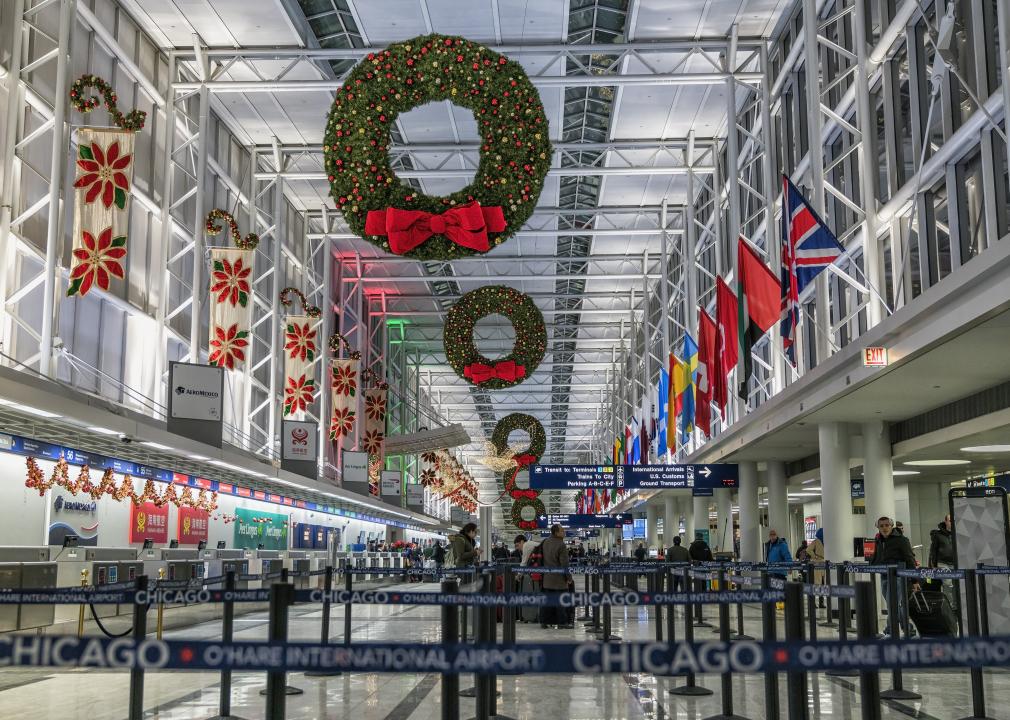
Revenge travel has waned, but the spirit of exploration remains
Christmas decorations at Chicago O’Hare International Airport.
Which Americans are traveling this holiday season and the choices they make around travel are markedly different in 2023. More Americans are traveling to reconnect with loved ones rather than for “revenge travel,” according to Deloitte.
Revenge travel, a phrase that started in social media circles and refers to the intentions of travelers to make up for trips lost during the COVID-19 pandemic, is dying down. For summer 2023 travel, 19% of those surveyed were motivated to take long trips after the pandemic paused travel, versus 12% for the end-of-year holiday season in 2023.
The other motivational categories for travel all increased: time with friends and family, rest and relaxation, and time with a partner or spouse for romance. Deloitte surmises that while revenge travel appears to be trending downward, “the recent restricted years seem to leave behind a legacy of enthusiasm for exploration.” Among Americans planning to take international trips, quite a few are looking to travel to South America and Asia.
More baby boomers are traveling again after more sustained restrictions than other age groups. Last year, older Americans avoided holiday travel due to potential travel disruptions and health concerns. One in 3 Boomers are traveling during the winter holidays compared to 1 in 5 in 2022.
While more Americans are pining to travel for the holidays, trips will be fewer and shorter. Travel will hover around the timing of major American holidays, though only 5% will take extended trips in 2023, down from 13% last year.
Budgets, however, have both decreased and increased in equal amounts. Eighteen percent of Deloitte’s survey respondents say their trip budget is significantly less in 2023. Of those who cut their budgets, 1 in 5 say their reduced spending will be spread across shorter trips or saving towards a bigger trip. Another 18% of respondents, however, report significantly higher budgets. One in 5 of those who allocated larger budgets now see more value in travel since the pandemic.
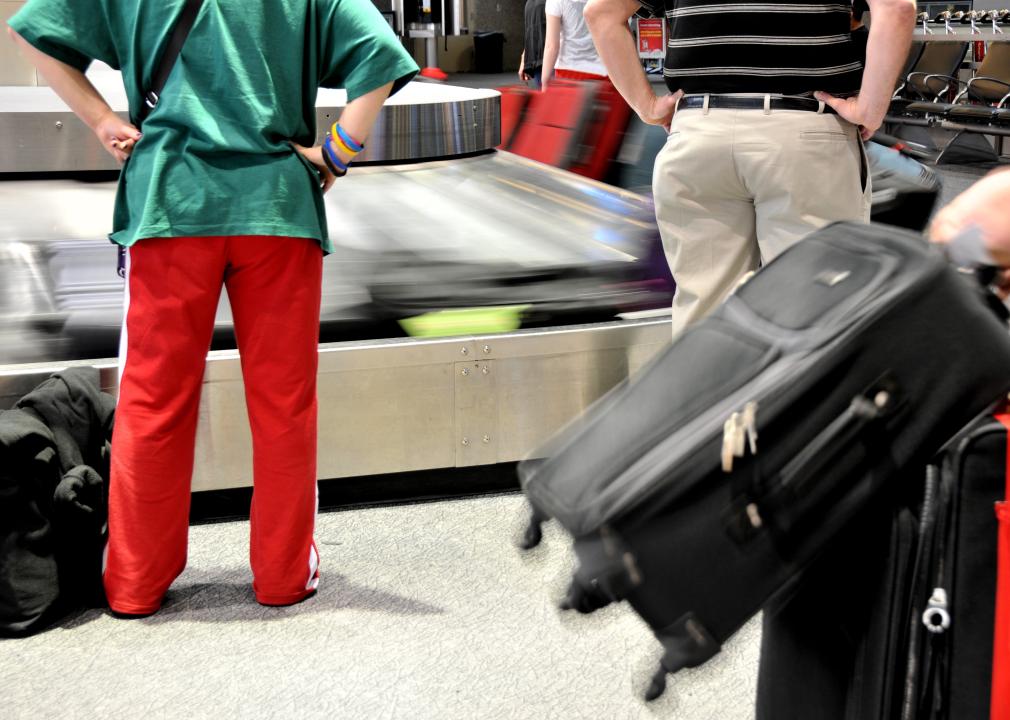
Amid cooling inflation, travel costs have dipped—slightly
Passengers wait for baggage at airport carousel.
Inflation and interest rates affect groups differently across locations, ages, incomes, races, and ethnicities. According to the Federal Reserve Bank of New York, Black, Hispanic, and middle-income households were the most affected largely because they spent the most on transportation , which led inflation in 2021. Yet while inflation’s impacts are inequitable, Americans across income strata are feeling it. Bankrate’s survey of Americans on finances during the holidays shows that at least a quarter of every income group reported worries about straining their budget.
Recently, however, travel costs have become relatively restrained. According to NerdWallet’s Travel Price Index, which tracks the change in travel prices against pre-pandemic levels, travel costs are down 2% when compared to the same month in 2022, but still 10% above October 2019 levels. In other words, expect a trip around this time to cost a bit less than a trip around the same time last year, but still more expensive than it was pre-pandemic.
Lindsay Schwimer, a spokesperson from travel booking site Hopper, told CBS News , “We’ve seen a shift back to normalcy in terms of prices, and a lot of the domestic airline capacity has come back to what we saw pre-pandemic, which means more planes flying than what we saw in past few years.”
With the continuation of remote or hybrid working for some Americans post-pandemic, some took advantage of a longer Thanksgiving break to spend more time with loved ones, also avoiding peak travel days.
Sophie Gardner and her husband, who are based in Chicago, utilize their flexible work arrangements around holidays like Thanksgiving and Christmas to drive up to Minnesota when the roads are clear. Gardner, who is a Director of Operations at Arabella Advisors says, “A flexible work schedule allows me to stay on top of my professional priorities while taking advantage of time with loved ones in the evening hours and on the weekend.”
Five travel days have been tacked onto the holiday season on average due to remote work, according to Deloitte.

Hello, revenge inflation spending
Girl counting U.S. dollar bills, using calculator, and taking notes.
Americans are also surprising economists with the levels of spending vs. saving despite the economy, according to Wall Street Journal consumer trends reporter Rachel Wolfe. She reported that while Americans are penny-pinching on everyday purchases by buying cheaper products or switching to generic brands, they are also spending on large-ticket items in what some people are calling “revenge inflation spending.”
“People do feel like they have a score to settle with inflation,” Wolfe told Your Money Briefing host J.R. Whalen. “They want to reclaim agency over their finances. They still have a job and want to feel like they live a good life. And so, they’re splurging on these more expensive items in order to feel like they still have an income.”
Wolfe reported speaking to a woman who has been concerned about money lately. To save, she cut back on therapy, plus canceled beauty appointments and media subscriptions—yet she still bought a last-minute trip to Cabo San Lucas, Mexico, saying “It feels good, and I’m just going to do it.”
A thread on Reddit echoed the “YOLO” sentiment in the face of housing inflation, where prices have continually increased for 12 years. User vblade2003 said , “Yep, when the system is rigged against you anyway, may as well enjoy life to the fullest. Take that life-changing trip to Europe, Asia, wherever instead of paying $1 million for a $400K house. Easiest choice ever.”
Fortunately, the airline industry was ready for a peak in 2023 for travelers. On the Sunday following Thanksgiving, the TSA hit a new record for the second time in the year as 2,907,378 people were screened at U.S. airports nationwide. The airlines only had to cancel less than 260 scheduled flights even as a cross-country storm delayed more than 900 flights in Chicago, in a major improvement from the last end-of-year holiday period in December 2022 when Southwest canceled more than 16,000 flights.
For those who haven’t booked a flight for the holidays yet, NerdWallet reports that Dec. 20, 27, and 30 are the top three busiest days in airports in the last four years, according to TSA checkpoint data. Steer clear of those days and book a deal when you see one. Remember, customers are allowed to cancel reservations within 24 hours of making a booking with no penalty.
Story editing by Carren Jao. Copy editing by Tim Bruns.
This story originally appeared on CoPilot and was produced and distributed in partnership with Stacker Studio.
Jump to comments ↓

Related Articles
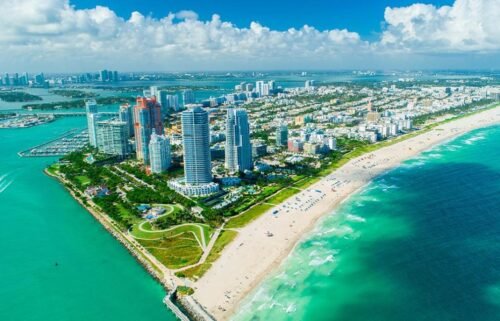
Which US vacation spots have the most amazing city views?

10 of the best places in the US to see the northern lights in 2024

Casino getaways: The top-ranked casinos for lavish rooms, celebrity sightings, budget-friendly rates, and more

Major US city skylines in photos, then and now
KVIA ABC 7 is committed to providing a forum for civil and constructive conversation.
Please keep your comments respectful and relevant. You can review our Community Guidelines by clicking here
If you would like to share a story idea, please submit it here .
- Today's news
- Reviews and deals
- Climate change
- 2024 election
- Fall allergies
- Health news
- Mental health
- Sexual health
- Family health
- So mini ways
- Unapologetically
- Buying guides
Entertainment
- How to Watch
- My watchlist
- Stock market
- Biden economy
- Personal finance
- Stocks: most active
- Stocks: gainers
- Stocks: losers
- Trending tickers
- World indices
- US Treasury bonds
- Top mutual funds
- Highest open interest
- Highest implied volatility
- Currency converter
- Basic materials
- Communication services
- Consumer cyclical
- Consumer defensive
- Financial services
- Industrials
- Real estate
- Mutual funds
- Credit cards
- Balance transfer cards
- Cash back cards
- Rewards cards
- Travel cards
- Online checking
- High-yield savings
- Money market
- Home equity loan
- Personal loans
- Student loans
- Options pit
- Fantasy football
- Pro Pick 'Em
- College Pick 'Em
- Fantasy baseball
- Fantasy hockey
- Fantasy basketball
- Download the app
- Daily fantasy
- Scores and schedules
- GameChannel
- World Baseball Classic
- Premier League
- CONCACAF League
- Champions League
- Motorsports
- Horse racing
- Newsletters
New on Yahoo
- Privacy Dashboard
Airfares were already dropping. Here’s why they could go even lower in 2024
Inflation has hit most of the economy, but that’s hardly the case with airfare. Not only are airfares down 6% year-over-year based on January 2024 prices, but they’re even down 15% versus a decade ago. That’s according to consumer price index data from the U.S. Bureau of Labor Statistics published in February. Some experts predict airfares to international destinations will drop even lower in 2024.
According to the American Express Global Business Travel Air Monitor 2024 report, prices on certain international routes may drop as much as 12%.
Here’s how AmEx GBT anticipates average economy airfares will change in 2024 versus 2023, for a sampling of regions:
— South America to North America: Drop by 11.9%.
— North America to Central America: Drop by 7.8%.
— North America to Asia: Drop by 7.5%.
— Asia to North America: Drop by 5.2%.
— North America to Europe: Drop by 3.5%.
— Europe to North America: Drop by 1.2%.
So, why are airfares dropping?
EXISTING AIRLINES ARE OFFERING MORE FLIGHTS AND ROUTES
2023 was a huge year for travel, with several records broken. The U.S. State Department issued a record 24 million passport books and cards during the 2023 fiscal year, signaling increased interest in travel abroad.
Katy Nastro, a spokesperson for airfare tracking website Going, has seen an increase in international flights booked as well.
“For example, in 2023, almost 14% more people flew between Costa Rica and the U.S. than pre-pandemic,” Nastro says.
Airlines added 10% more flights between the U.S. and Central America in 2023 versus 2022, according to scheduling data analyzed by Going from aviation analytics company Cirium Diio. In 2024, airlines are expected to add another 10%.
Last year’s high traveler volume has prompted airlines to increase flight schedules to other parts of the world. For example, Delta Air Lines announced that — in light of a record-setting summer 2023 — it would launch its largest-ever transatlantic schedule for summer 2024. That includes new daily service from New York to Naples, Italy, beginning in May, as well as more flights from the U.S. to Paris; Venice, Italy; Barcelona, Spain; and Dublin.
For travel from North America to Asia, there are 5.5 million more airline seats for sale in the first half of 2024 versus the same period in 2023. That’s a 35% year-over-year increase, says Jeremy Quek, principal global air practice line lead at AmEx GBT.
“More availability in turn can help with pricing,” Nastro says. “Heading into 2024, in theory, this should reduce overall prices.”
BUDGET AIRLINES ARE BRINGING DOWN PRICES
New, smaller airlines (particularly low-cost carriers) are also competing for customers, which helps bring down airfares industrywide.
For example, Norse Atlantic Airways is a Norwegian low-cost airline that started flying to the U.S. in 2022. Now it operates 13 routes between the U.S. and five European cities. Come May 2024, Norse will launch summer flights between New York and Athens, Greece.
A RETURN TO NORMALCY AFTER COVID-19
Quek says much of the phenomenon of falling airfares is a post-COVID-19 pandemic recalibration, considering so many airlines reduced schedules in 2020.
“Airline schedules, especially on long-haul international flights, are set at least six months out,” Quek says. “Restarting a route can take even longer. As countries announced border reopenings, airlines were constrained on how quickly they could reintroduce flights.”
And it’s not just schedules returning to normal, but airfares too. Airfares originating in the U.S. hit all-time highs in May 2022, according to Bureau of Labor Statistics data, when the summer of “revenge travel” was in full swing. Quek says this year’s price decreases are largely a return to pre-pandemic equilibrium rather than an extraordinary drop in prices.
AIRFARES ARE FALLING, BUT DON’T WAIT TO BOOK
Though airfares are falling, don’t delay booking in hopes that they’ll fall further. Going advises booking two to eight months out for international travel.
“Airfares tend to increase the closer you get to booking,” Nastro says. “In reality, it is far more likely for airlines to sell tickets at higher prices at the last minute.”
____________________________________
This article was provided to The Associated Press by the personal finance website NerdWallet. Sally French is a writer at NerdWallet. Email: [email protected].
RELATED LINK:
NerdWallet: Travel inflation price tracker https://bit.ly/nerdwallet-travel-inflation-price-tracker
Recommended Stories
2024 nfl draft grades: denver broncos earn one of our lowest grades mostly due to one pick.
Yahoo Sports' Charles McDonald breaks down the Broncos' 2024 draft.
NFL Power Rankings, draft edition: Did Patriots fix their offensive issues?
Which teams did the best in the NFL Draft?
Formula 1: Miami Grand Prix sends cease and desist letter to prevent Donald Trump fundraiser during race
Race organizers say they'll revoke a Trump fundraiser's suite license if he holds an event for the former president on Sunday at the race.
NFL Draft: Packers fan upset with team's 1st pick, and Lions fans hilariously rubbed it in
Not everyone was thrilled with their team's draft on Thursday night.
Does castor oil really help with hair growth? We asked the experts, and their answer may surprise you
It's inexpensive, but is it effective? Dermatologists' verdict is in — and it's unanimous.
New details emerge in alleged gambling ring behind Shohei Ohtani-Ippei Mizuhara scandal
It turns out the money was going from Ohtani's bank account to an illegal bookie to ... casinos.
CVS stock plunges after earnings numbers one analyst 'did not even believe'
CVS warns it could cede Medicare Advantage market share as reimbursement rates pressure the company.
The best RBs for 2024 fantasy football according to our experts
The Yahoo Fantasy football analysts reveal their first running back rankings for the 2024 season.
NFL Draft grades for all 32 teams | Zero Blitz
Jason Fitz and Frank Schwab join forces to recap the draft in the best way they know how: letter grades! Fitz and Frank discuss all 32 teams division by division as they give a snapshot of how fans should be feeling heading into the 2024 season. The duo have key debates on the Dallas Cowboys, New York Giants, New Orleans Saints, Los Angeles Rams, New England Patriots, Las Vegas Raiders and more.
Canelo Álvarez and Oscar De La Hoya erupt in heated exchange ahead of title bout with Jaime Munguía
Canelo Álvarez is set to defend his title against undefeated Jaime Munguía on Saturday in Las Vegas.
NBA playoffs: Luka Dončić leads Mavericks in blowout win over Clippers to take 3-2 series lead
Luka Dončić singlehandedly outscored Paul George, James Harden and Russell Westbrook.
NFL to allow players to wear protective Guardian Caps in games beginning with 2024 season
The NFL will allow players to wear protective Guardian Caps during games beginning with the 2024 season. The caps were previously mandated for practices.
2024 NFL Draft grades for all 32 teams
While the Falcons baffled everyone, the defending champion Chiefs looked like champs again.
Wide receiver rankings for 2024 fantasy football
The Yahoo Fantasy football analysts reveal their first wide receiver rankings for the 2024 season.
MLB Power Rankings: Braves move into the top spot followed by Dodgers, Phillies as injuries take a toll across the league
From the Braves to the Marlins, here's where all 30 teams stand after the season's first month.
The expanded 12-team College Football Playoff is here — and it already has problems
There is cause for excitement around the new playoff format. There's also lots of complaints and criticism to go around.
Ex-Florida State QB and 1999 Fiesta Bowl starter Marcus Outzen dies at 46
The Seminoles lost 23-16 to Tennessee in the first-ever BCS title game.
Dolphins owner Stephen Ross reportedly declined $10 billion for team, stadium and F1 race
The value of the Dolphins and Formula One racing is enormous.
Best places to get your car maintained and repaired
Consumer Reports offers a quick guide, with a few examples, of when you should get your car maintained and repaired at a dealership, vs. an independent shop, vs. a chain.
Korey Cunningham, former NFL lineman, found dead in New Jersey home at age 28
Cunningham played 31 games in the NFL with the Cardinals, Patriots and Giants.
UK Edition Change
- UK Politics
- News Videos
- Paris 2024 Olympics
- Rugby Union
- Sport Videos
- John Rentoul
- Mary Dejevsky
- Andrew Grice
- Sean O’Grady
- Photography
- Theatre & Dance
- Culture Videos
- Fitness & Wellbeing
- Food & Drink
- Health & Families
- Royal Family
- Electric Vehicles
- Car Insurance Deals
- Lifestyle Videos
- UK Hotel Reviews
- News & Advice
- Simon Calder
- Australia & New Zealand
- South America
- C. America & Caribbean
- Middle East
- Politics Explained
- News Analysis
- Today’s Edition
- Home & Garden
- Broadband deals
- Fashion & Beauty
- Travel & Outdoors
- Sports & Fitness
- Sustainable Living
- Climate Videos
- Solar Panels
- Behind The Headlines
- On The Ground
- Decomplicated
- You Ask The Questions
- Binge Watch
- Travel Smart
- Watch on your TV
- Crosswords & Puzzles
- Most Commented
- Newsletters
- Ask Me Anything
- Virtual Events
- Betting Sites
- Online Casinos
- Wine Offers
Thank you for registering
Please refresh the page or navigate to another page on the site to be automatically logged in Please refresh your browser to be logged in
Airfares were already dropping. Here’s why they could go even lower in 2024
U.s. airfares are, on average, 15% lower now than they were a decade ago, and 6% lower than this time last year, article bookmarked.
Find your bookmarks in your Independent Premium section, under my profile
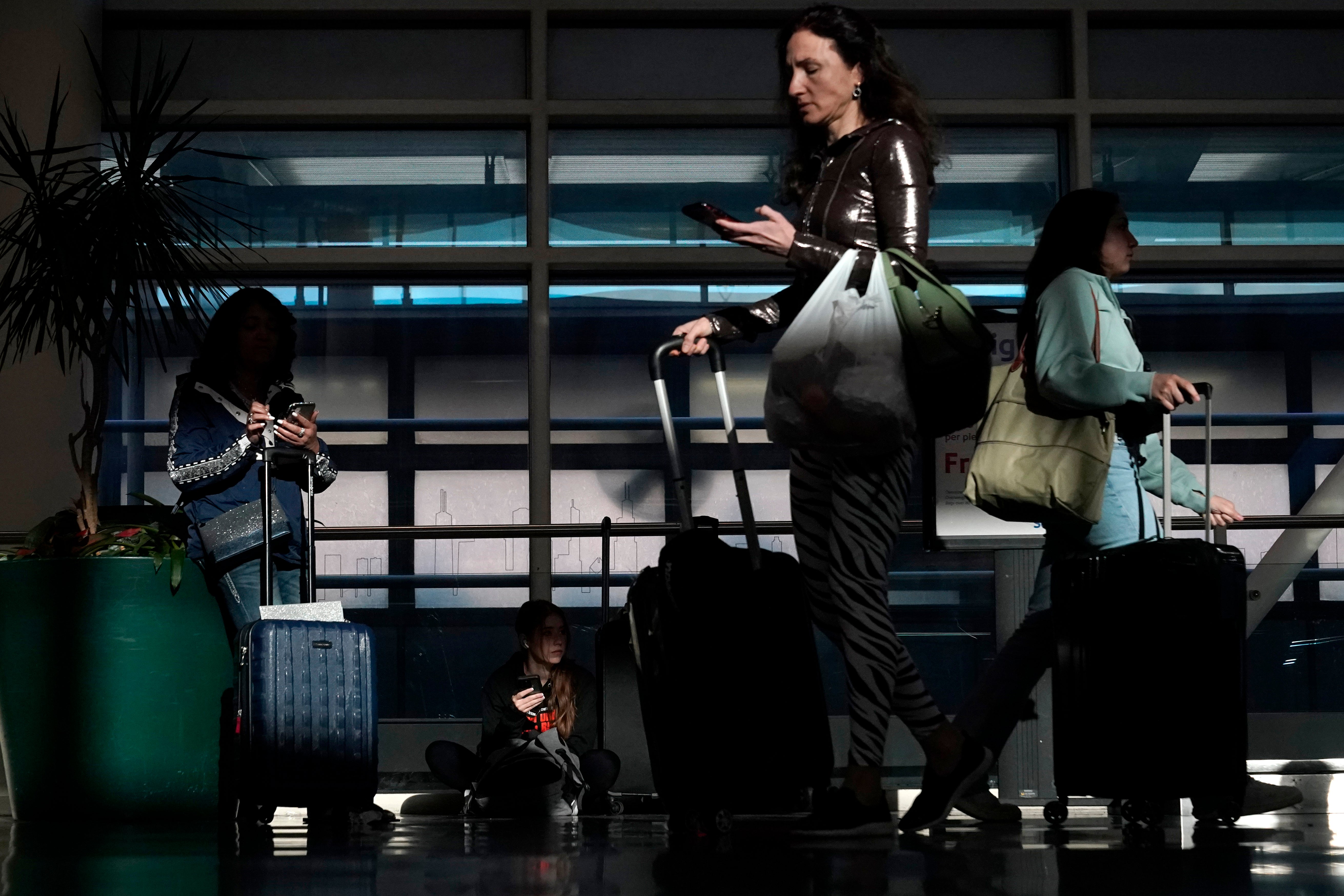
For free real time breaking news alerts sent straight to your inbox sign up to our breaking news emails
Sign up to our free breaking news emails, thanks for signing up to the breaking news email.
Inflation has hit most of the economy, but that’s hardly the case with airfare. Not only are airfares down 6% year-over-year based on January 2024 prices, but they’re even down 15% versus a decade ago. That’s according to consumer price index data from the U.S. Bureau of Labor Statistics published in February. Some experts predict airfares to international destinations will drop even lower in 2024.
According to the American Express Global Business Travel Air Monitor 2024 report, prices on certain international routes may drop as much as 12%.
Here’s how AmEx GBT anticipates average economy airfares will change in 2024 versus 2023, for a sampling of regions:
— South America to North America: Drop by 11.9%.
— North America to Central America: Drop by 7.8%.
— North America to Asia: Drop by 7.5%.
— Asia to North America: Drop by 5.2%.
— North America to Europe: Drop by 3.5%.
— Europe to North America: Drop by 1.2%.
So, why are airfares dropping?
EXISTING AIRLINES ARE OFFERING MORE FLIGHTS AND ROUTES
2023 was a huge year for travel, with several records broken. The U.S. State Department issued a record 24 million passport books and cards during the 2023 fiscal year, signaling increased interest in travel abroad.
Katy Nastro, a spokesperson for airfare tracking website Going, has seen an increase in international flights booked as well.
“For example, in 2023, almost 14% more people flew between Costa Rica and the U.S. than pre-pandemic,” Nastro says.
Airlines added 10% more flights between the U.S. and Central America in 2023 versus 2022, according to scheduling data analyzed by Going from aviation analytics company Cirium Diio. In 2024, airlines are expected to add another 10%.
Last year’s high traveler volume has prompted airlines to increase flight schedules to other parts of the world. For example, Delta Air Lines announced that — in light of a record-setting summer 2023 — it would launch its largest-ever transatlantic schedule for summer 2024. That includes new daily service from New York to Naples, Italy, beginning in May, as well as more flights from the U.S. to Paris; Venice, Italy; Barcelona, Spain; and Dublin.
For travel from North America to Asia, there are 5.5 million more airline seats for sale in the first half of 2024 versus the same period in 2023. That’s a 35% year-over-year increase, says Jeremy Quek, principal global air practice line lead at AmEx GBT.
“More availability in turn can help with pricing,” Nastro says. “Heading into 2024, in theory, this should reduce overall prices.”
BUDGET AIRLINES ARE BRINGING DOWN PRICES
New, smaller airlines (particularly low-cost carriers) are also competing for customers, which helps bring down airfares industrywide.
For example, Norse Atlantic Airways is a Norwegian low-cost airline that started flying to the U.S. in 2022. Now it operates 13 routes between the U.S. and five European cities. Come May 2024, Norse will launch summer flights between New York and Athens, Greece.
A RETURN TO NORMALCY AFTER COVID-19
Quek says much of the phenomenon of falling airfares is a post-COVID-19 pandemic recalibration, considering so many airlines reduced schedules in 2020.
“Airline schedules, especially on long-haul international flights, are set at least six months out,” Quek says. “Restarting a route can take even longer. As countries announced border reopenings, airlines were constrained on how quickly they could reintroduce flights.”
And it’s not just schedules returning to normal, but airfares too. Airfares originating in the U.S. hit all-time highs in May 2022, according to Bureau of Labor Statistics data, when the summer of “revenge travel” was in full swing. Quek says this year’s price decreases are largely a return to pre-pandemic equilibrium rather than an extraordinary drop in prices.
AIRFARES ARE FALLING, BUT DON’T WAIT TO BOOK
Though airfares are falling, don’t delay booking in hopes that they’ll fall further. Going advises booking two to eight months out for international travel.
“Airfares tend to increase the closer you get to booking,” Nastro says. “In reality, it is far more likely for airlines to sell tickets at higher prices at the last minute.”
____________________________________
This article was provided to The Associated Press by the personal finance website NerdWallet. Sally French is a writer at NerdWallet. Email: [email protected].
RELATED LINK:
NerdWallet: Travel inflation price tracker https://bit.ly/nerdwallet-travel-inflation-price-tracker
Subscribe to Independent Premium to bookmark this article
Want to bookmark your favourite articles and stories to read or reference later? Start your Independent Premium subscription today.
New to The Independent?
Or if you would prefer:
Want an ad-free experience?
Hi {{indy.fullName}}
- My Independent Premium
- Account details
- Help centre
- Account Profile
- Newsletters

- Today’s Stories
- Entertainment
- Classifieds
Airfares were already dropping. Here’s why they could go even lower in 2024
Inflation has hit most of the economy, but that’s hardly the case with airfare. Not only are airfares down 6% year-over-year based on January 2024 prices, but they’re even down 15% versus a decade ago. That’s according to consumer price index data from the U.S. Bureau of Labor Statistics published in February. Some experts predict airfares to international destinations will drop even lower in 2024.
According to the American Express Global Business Travel Air Monitor 2024 report, prices on certain international routes may drop as much as 12%.
Here’s how AmEx GBT anticipates average economy airfares will change in 2024 versus 2023, for a sampling of regions:
• South America to North America: Drop by 11.9%.
• North America to Central America: Drop by 7.8%.
• North America to Asia: Drop by 7.5%.
• Asia to North America: Drop by 5.2%.
• North America to Europe: Drop by 3.5%.
• Europe to North America: Drop by 1.2%.
So, why are airfares dropping?
EXISTING AIRLINES ARE OFFERING MORE FLIGHTS AND ROUTES
2023 was a huge year for travel, with several records broken. The U.S. State Department issued a record 24 million passport books and cards during the 2023 fiscal year, signaling increased interest in travel abroad.
Katy Nastro, a spokesperson for airfare tracking website Going, has seen an increase in international flights booked as well.
“For example, in 2023, almost 14% more people flew between Costa Rica and the U.S. than pre-pandemic,” Nastro says.
Airlines added 10% more flights between the U.S. and Central America in 2023 versus 2022, according to scheduling data analyzed by Going from aviation analytics company Cirium Diio. In 2024, airlines are expected to add another 10%.
Last year’s high traveler volume has prompted airlines to increase flight schedules to other parts of the world. For example, Delta Air Lines announced that — in light of a record-setting summer 2023 — it would launch its largest-ever trans-Atlantic schedule for summer 2024. That includes new daily service from New York to Naples, Italy, beginning in May, as well as more flights from the U.S. to Paris; Venice, Italy; Barcelona, Spain; and Dublin.
For travel from North America to Asia, there are 5.5 million more airline seats for sale in the first half of 2024 versus the same period in 2023. That’s a 35% year-over-year increase, says Jeremy Quek, principal global air practice line lead at AmEx GBT.
“More availability in turn can help with pricing,” Nastro says. “Heading into 2024, in theory, this should reduce overall prices.”
BUDGET AIRLINES ARE BRINGING DOWN PRICES
New, smaller airlines (particularly low-cost carriers) are also competing for customers, which helps bring down airfares industrywide.
For example, Norse Atlantic Airways is a Norwegian low-cost airline that started flying to the U.S. in 2022. Now it operates 13 routes between the U.S. and five European cities. Come May 2024, Norse will launch summer flights between New York and Athens, Greece.
A RETURN TO NORMALCY AFTER COVID-19
Quek says much of the phenomenon of falling airfares is a post-COVID-19 pandemic recalibration, considering so many airlines reduced schedules in 2020.
“Airline schedules, especially on long-haul international flights, are set at least six months out,” Quek says. “Restarting a route can take even longer. As countries announced border reopenings, airlines were constrained on how quickly they could reintroduce flights.”
And it’s not just schedules returning to normal, but airfares too. Airfares originating in the U.S. hit all-time highs in May 2022, according to Bureau of Labor Statistics data, when the summer of “revenge travel” was in full swing. Quek says this year’s price decreases are largely a return to pre-pandemic equilibrium rather than an extraordinary drop in prices.
AIRFARES ARE FALLING, BUT DON’T WAIT TO BOOK
Though airfares are falling, don’t delay booking in hopes that they’ll fall further. Going advises booking two to eight months out for international travel.
“Airfares tend to increase the closer you get to booking,” Nastro says. “In reality, it is far more likely for airlines to sell tickets at higher prices at the last minute.”
____________________________________
This article was provided to The Associated Press by the personal finance website NerdWallet. Sally French is a writer at NerdWallet. Email: [email protected].
RELATED LINK:
NerdWallet: Travel inflation price tracker https://bit.ly/nerdwallet-travel-inflation-price-tracker
- Daily Herald Events
- Daily Herald Media Group News
- Privacy Policy
- Terms of Service
- Advertising/Marketing
- Jobs at Paddock Publications
- Share Article or Event
- About our Ads
- Place a Classified Ad
- Business Directory
- Email Newsletters
Where Americans are traveling in 2024: By the numbers
- Published: Apr. 28, 2024, 12:36 p.m.
- NerdWallet | special to cleveland.com
Americans are traveling abroad in droves.
The number of U.S. citizens flying to international destinations reached nearly 6.5 million passengers in March, according to the International Trade Administration. That’s the highest March total in over five years and shows that the post-pandemic “revenge travel” trend is the new normal.
It wasn’t just March, which usually sees a spike in international departures for spring break. In every month of 2024 so far, more Americans left the country than last year and 2019. These trends point to a blockbuster summer for overseas travel.
Nearly half of Americans (45%) plan to travel by air and/or stay in a hotel this summer and expect to spend $3,594 on average, on these expenses, according to a survey of 2,000 U.S. adults, conducted online by The Harris Poll and commissioned by NerdWallet.
That’s despite rising travel prices that have caused some hesitancy among would-be travelers. About 22% of those choosing not to travel this summer cite inflation making travel too expensive as a reason for staying home, according to the poll.
So where are traveling Americans going? And what does it mean for those looking to avoid crowds of tourists and higher travel prices?
New travel patterns
Nearly every region in the world saw an increase in U.S. visitors in March 2024 compared with March 2023, according to International Trade Administration data. Only the Middle East saw a decline of 9%. Yet not every region saw the same year-over-year bump. U.S. visitors to Asia saw a 33% jump, while Oceania and Central America each saw a 30% increase.
Comparing 2024 with 2023 only tells part of the story, however. The new patterns really emerge when comparing international travel trends to 2019. For example, Central America received 50% more U.S. visitors in March 2024 compared with March 2019. Nearly 1.5 million Americans visited Mexico, up 39% compared with before the pandemic. That’s almost as many visitors as the entire continent of Europe, which has seen a more modest 10% increase since 2019.
Only Canada and Oceania saw fewer visitors in March 2024 than in 2019, suggesting that interest in these locations has not rebounded. Indeed, the trends indicate a kind of tourism inertia from COVID-19 pandemic-era lockdowns: Those destinations that were more open to U.S. visitors during the pandemic, such as Mexico, have remained popular, while those that were closed, such as Australia, have fallen off travelers’ radars.
Price pressures
How these trends play out throughout the rest of the year will depend on a host of factors. Yet, none will likely prove more important than affordability. After months of steadiness, the cost of travel, including airfare, hotels and rental cars, has begun to sneak up again.
About 45% of U.S. travelers say cost is their main consideration when planning their summer vacation, according to a survey of 2,000 Americans by the travel booking platform Skyscanner.
That’s likely to weigh further on U.S. travelers’ appetite for visiting expensive destinations such as Europe, while encouraging travel to budget-friendly countries. It could also depress overall international travel as well, yet so far, Americans seem to be traveling more.
For those looking to avoid crowds while maintaining a budget, Skyscanner travel trends expert Laura Lindsay offered a recommendation many of us might need help finding on a map.
“Albania has been on the radar of travelers looking for something different,” Lindsay said. “Most people have yet to discover it, but flights and tourism infrastructure are in place, and there are fewer crowds in comparison to trending European destinations like Italy, Greece, or Portugal.”
On the flip side, American travelers looking to avoid crowds of compatriots would do well to avoid Japan, which has seen a staggering 50% increase in U.S. tourists between March 2019 and 2024.
More From NerdWallet
- 8 Hotel Afternoon Teas Around the World Worth a Visit
- 5 Airport Lines You Can Ditch (and How to Skip Them for Free)
- How to Navigate Those Confusing Airline Fare Bundles
Sam Kemmis writes for NerdWallet. Email: [email protected] . Twitter: @samsambutdif.
The article Where Americans Are Traveling in 2024: By the Numbers originally appeared on NerdWallet.
If you purchase a product or register for an account through a link on our site, we may receive compensation. By using this site, you consent to our User Agreement and agree that your clicks, interactions, and personal information may be collected, recorded, and/or stored by us and social media and other third-party partners in accordance with our Privacy Policy.
Advertisement
Supported by
Inflation Is Stubborn. Is the Federal Budget Deficit Making It Worse?
Economists are divided over whether the growing amount of federal borrowing is fueling demand and driving up prices.
- Share full article

By Jim Tankersley
Jim Tankersley covers economic policy from the White House
A crucial question is hanging over the American economy and the fall presidential election: Why are consumer prices still growing uncomfortably fast , even after a sustained campaign by the Federal Reserve to slow the economy by raising interest rates?
Economists and policy experts have offered several explanations. Some are essentially quirks of the current economic moment, like a delayed, post-pandemic surge in the cost of home and auto insurance . Others are long-running structural issues, like a lack of affordable housing that has pushed up rents in big cities like New York as would-be tenants compete for units.
But some economists, including top officials at the International Monetary Fund, said that the federal government bore some of the blame because it had continued to pump large amounts of borrowed money into the economy at a time when the economy did not need a fiscal boost.
That borrowing is a result of a federal budget deficit that has been elevated by tax cuts and spending increases. It is helping to fuel demand for goods and services by channeling money to companies and people who then go out and spend it.
I.M.F. officials warned that the deficit was also increasing prices. In a report earlier this month, they wrote that while America’s recent economic performance was impressive, it was fueled in part by a pace of borrowing “that is out of line with long-term fiscal sustainability.”
The I.M.F. said that U.S. fiscal policies were adding about a half a percentage point to the national inflation rate and raising “short-term risks to the disinflation process” — essentially saying that the government was working at cross-purposes with the Fed.
Biden administration economists, and some analysts on Wall Street, reject that view. Administration officials said that the analysis underlying the I.M.F.’s claims was implausible. That’s in part because the report found that federal policy was adding just as much to inflation currently as it did two years ago, at a time when direct payments to consumers and other programs from President Biden’s 2021 stimulus bill were increasing spending across the economy.
Administration officials pointed to other measures of fiscal policy , including a continuing analysis by the Brookings Institution in Washington, that suggested that government tax and spending policies were not significantly adding to economic growth or inflation now or in the recent past.
“I don’t think the recent inflation record supports an excessive demand story,” Jared Bernstein, the chairman of the White House Council of Economic Advisers, said in an interview. “I think what we’ve seen is that as supply chains have unsnarled, demand in the job market has cooled somewhat. We’ve been able to maintain historically low unemployment while getting significant disinflation.”
Mr. Bernstein added that, while administration officials were careful not to comment on the central bank’s interest rate decisions, “our fiscal stance is not fighting the Fed.”
The debate is important for how the Fed, which bears primary responsibility for controlling price growth, sets policy in the months ahead.
Investors entered the year expecting Fed officials to cut interest rates several times, after price growth slowed rapidly in 2023 and began to approach the central bank’s target level of 2 percent per year. They have revised those forecasts as new data show that progress stalling out and, by many measures, beginning to reverse.
How policymakers view the interplay between deficits and inflation could also shape decisions by the next president and Congress. If re-elected, Mr. Biden said that he would seek to reduce deficits by about $3 trillion over a decade, primarily by raising taxes on high earners and corporations. His Republican opponent, former President Donald J. Trump, has repeated his past — and unfulfilled — promises to eliminate the national debt , while also pushing for an extension of his 2017 tax cuts that could add trillions to deficits.
Both presidents’ policies, along with decisions by presidents before them , have contributed to the nation’s current fiscal imbalance. The deficit spiked when Mr. Trump, and then Mr. Biden, signed relief bills for people and businesses amid the coronavirus pandemic. It fell in the 2022 fiscal year but effectively doubled last year .
The deficit is now larger, as a share of the economy, than is historically normal for this point in an economic recovery — when unemployment is low and economic growth remains strong.
That is even true if you exclude the costs of servicing the government’s mounting debt load, which jumped last year as the Fed raised interest rates, a measure economists call the “primary deficit.” When properly measured, the primary deficit last year was equal to about 5 percent of the economy’s annual output. Data from the nonpartisan Congressional Budget Office suggest that it was the sixth-highest primary deficit of any year since 1962; the other five all came during, or immediately after, the pandemic or the 2008 financial crisis.
High deficits could affect inflation in a few ways. They could increase demand for goods or services that remain in relatively short supply, driving up prices. They could affect consumers’ views about how much inflation they expect in the future and chip away at the effectiveness of Fed rate increases to slow growth, said Joseph H. Davis, the chief global economist at the investment firm Vanguard.
Mr. Davis said that the shift from a declining deficit to a rising one was most likely adding modestly to price growth and making the Fed’s job more difficult: “What used to be a tailwind on inflation has become more of a headwind,” he said.
The deficit increase last year reflected several factors, including volatile capital gains tax collections and the effects of natural disasters on tax filing. It also reflected increased government spending and tax breaks signed into law by Mr. Biden. A bipartisan 2021 infrastructure bill is now funding roads, broadband and other projects nationwide. The government is paying for additional health benefits for veterans exposed to toxic burn pits.
Tax incentives in a bipartisan law meant to encourage semiconductor production and a party-line law intended to accelerate the transition from fossil fuels to lower-emission energy sources have spurred hundreds of billions of dollars in announcements or spending on new factory construction.
“It was a large dose of fiscal stimulus over the last year,” said Jason Furman, a Harvard economist who chaired the White House Council of Economic Advisers under President Barack Obama. “To get people lower mortgage rates,” he added, “to give businesses the ability to expand and invest and grow, we need to be bringing the deficit down.”
Data from other economists, like the creators of the Hutchins Center Fiscal Impact Measure at Brookings, suggest that the increase in spending and tax breaks last year did not outweigh the drag on the economy from expiring Covid relief. In other words, they effectively show that the end of stimulus aid that propped up consumer demand in the early stages of the pandemic offset any increased demand from new spending and tax breaks.
Economists at the investment bank UBS wrote last week that after adding to growth last year, including by fueling factory construction, federal tax and spending policy was likely to “flip” to dragging on growth this year. Economists at Bank of America Securities made a similar case last week after the Commerce Department reported that economic growth slowed in the first months of this year.
Administration officials said there were simpler — and superior — explanations for why price growth remained above the Fed’s target than the deficit. Housing inflation has not moderated as quickly as many economists expected, though White House models predict it will soon. Price growth in auto insurance, financial services and medical services are effectively one-offs that are keeping inflation elevated now, the officials said, but will not continue to push prices higher in the months to come.
“It’s not really a fiscal story,” Mr. Bernstein said.
Jim Tankersley writes about economic policy at the White House and how it affects the country and the world. He has covered the topic for more than a dozen years in Washington, with a focus on the middle class. More about Jim Tankersley

IMAGES
COMMENTS
In fact, average consumer prices across all items rose 3.5% year-over-year through March. According to NerdWallet's Travel Price Index, the overall cost of travel is down 2% from the same month in ...
Research: Developed by the U.S. Travel Association, the Travel Price Index (TPI) measures the one-month change in the cost of travel ("travel inflation") away from home in the United States on a seasonally adjusted basis and the 12-month change of the cost of travel away from home in the U.S. on a seasonally unadjusted basis. The TPI is released monthly and is directly comparable to the CPI.
New data from the United States government highlights how inflation is impacting prices across the travel industry. According to the Bureau of Labor Statistics' Consumer Price Index, airfares in the U.S. rose by 26 percent in January compared to the same month last year. The price increase outpaces the 6.4 percent year-over-year jump for the ...
Nerdwallet's research finds it also costs more to do things on vacation. Eating out costs 7.2% more than it did last year, and tickets for movies and concerts are up nearly 6%.
Last updated: 9:52 AM ET, Wed September 14, 2022. The latest Bureau of Labor Statistics' Consumer Price Index (CPI) showed that prices rose slightly in August, making inflation worse for potential travelers and possibly causing the Federal Reserve to increase interest rates next week. According to ABCNews.com, the CPI rose 0.1 percent in August ...
A recent Bankrate survey found 63% of U.S. adults have traveled or plan to travel for leisure this year, up from 58% last year. At the same time, the share of those citing higher prices as a top ...
Holiday travelers who make under $50,000 per year are most likely (86 percent) of any income bracket to change their plans due to inflation or rising prices this year, according to Bankrate. The ...
NerdWallet refreshed its annual analysis of points and miles programs and found something unexpected in a sea of bad inflation news: Many rewards programs' points have become more valuable this year compared with the previous year. American Airlines' miles increased in value, from 1.2 cents per mile in 2021 to 1.5 cents in 2022.
Hyatt, for example, still maintains an award chart and saw its points increase in value from 1.9 cents to 2.8 cents from 2021 to 2022, according to the NerdWallet analysis.
2023 was a huge year for travel, with several records broken. The U.S. State Department issued a record 24 million passport books and cards during the 2023 fiscal year, signaling increased ...
SHIFTING PRIORITIES. The surge of "revenge travel" in summer 2022 and early 2023 caused prices to spike. Yet these prices peaked in March of this year, according to the NerdWallet travel price ...
From car rentals to hotels and eating out to flights, the overall cost of travel is up 18% compared to April 2019, according to NerdWallet's Travel Price Index. On a shorter scale, their data ...
Amid cooling inflation, travel costs have dipped—slightly. ... NerdWallet reports that Dec. 20, 27, and 30 are the top three busiest days in airports in the last four years, according to TSA ...
Here are some of the top ways Americans may be able to reduce the overall cost of a trip, according to travel experts. 1. Be flexible with trip timing and location. Being flexible with your plans ...
SALLY FRENCH of NerdWallet. Updated February 28, 2024 · 4 min read. FILE - Commercial airline passengers wait, and make their way through the ticketing level at Chicago's Midway International Airport Friday, May 26, 2023, in Chicago. U.S. airfares are, on average, 15% lower now than they were a decade ago, and 6% lower than this time last year.
According to the American Express Global Business Travel Air Monitor 2024 report, prices on certain international routes may drop as much as 12%. ... NerdWallet: Travel inflation price tracker ...
Here's why they could go even lower in 2024. U.S. airfares are, on average, 15% lower now than they were a decade ago, and 6% lower than this time last year. The same cannot be said for many ...
About 22% of those choosing not to travel this summer cite inflation making travel too expensive as a reason for staying home, according to the poll. ... More From NerdWallet.
The inflation-based rate is currently 3.94% and will fall to 2.96% on May 1. How the Treasury Department will adjust the fixed rate, which is at 1.30%—its highest level since 2007—is still ...
I.M.F. officials warned that the deficit was also increasing prices. In a report earlier this month, they wrote that while America's recent economic performance was impressive, it was fueled in ...